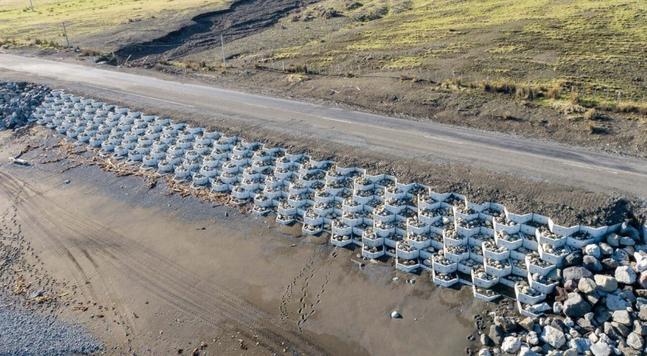Dunedin Council has installed hexagonal, fibre-reinforced concrete modules for erosion control on a section of Taieri Mouth road. They're made in NZ and will eventually be planted with natives.
@BobLefridge any idea what the fibre is? Glass I’m guessing, really hope it isn’t plastic …
It's not mentioned in the press release. Hopefully an inspired journalist will ask a few questions.
They'd score bonus points if they used hemp fibre.
@BobLefridge
I usually think of biodegradability as a good thing, but this doesn't strike me as the best use case for reinforcing that rots in the wet
@gwilymgj
I usually think of biodegradability as a good thing, but this doesn't strike me as the best use case for reinforcing that rots in the wet
@gwilymgj
@RedRobyn @BobLefridge @gwilymgj
I will second that
Biodegradable material does not belong in concrete
Hempcrete is a very bad idea.
@BobLefridge
Concrete is porous, which is why so many basement conversions are so unhealthy. Concrete retaining walls need a damp-proof membrane between them and the earth behind them if they are to be enclosed in an interior space. These eco-reef things are meant to be submerged in water.
Whilst I don't have a lot of knowledge of hempcrete I have a strong suspicion it's like straw bale, rammed earth and adobe houses. Which, the wishful thinking of various alternative lifestylers notwithstanding, are not suitable for all climates. You can do a certain amount with clever design, and high quality waterproof coatings. but if there's something in there that needs to be kept quite dry to maintain structural integrity its really only suitable for a desert. At least hempcrete doesn't make a rodent habitat the way straw bale houses do.
@gwilymgj
Concrete is porous, which is why so many basement conversions are so unhealthy. Concrete retaining walls need a damp-proof membrane between them and the earth behind them if they are to be enclosed in an interior space. These eco-reef things are meant to be submerged in water.
Whilst I don't have a lot of knowledge of hempcrete I have a strong suspicion it's like straw bale, rammed earth and adobe houses. Which, the wishful thinking of various alternative lifestylers notwithstanding, are not suitable for all climates. You can do a certain amount with clever design, and high quality waterproof coatings. but if there's something in there that needs to be kept quite dry to maintain structural integrity its really only suitable for a desert. At least hempcrete doesn't make a rodent habitat the way straw bale houses do.
@gwilymgj

